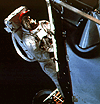|
| |

Apollo 9
 |
(L)
James A. McDivitt |
Commander |
| (C)
David R. Scott |
Command Module
Pilot |
| (R)
Russell L. Schweickart |
Lunar Module Pilot |
Crew Spaceflight Histories
| James A. McDivitt |
| |
Mission |
Dates |
Role |
Notes |
|
Gemini IV |
June 3-7, 1965 |
Commander |
|
| |
Apollo
9 |
March 3-13, 1969 |
Commander |
|
| |
| David R. Scott |
| |
Mission |
Dates |
Role |
Notes |
| |
Gemini VIII |
March 16, 1966 |
Pilot |
|
| |
Apollo
9 |
March 3-13, 1969 |
Command Module
Pilot |
|
|
Apollo
15 |
July 26-Aug 7, 1971 |
Commander |
|
| |
| Russell L. Schweickart |
| |
Mission |
Dates |
Role |
Notes |
| |
Apollo
9 |
March 3-13, 1969 |
Lunar Module Pilot |
|
| |
Apollo 9 Backup Crew:
|
The
Apollo 9 mission was launched from Cape Kennedy at 11 a.m. EST on March
3, 1969 from Launch complex 39A. The primary objectives were to demonstrate
crew, space vehicle and mission support facilities performance during a manned
Saturn V mission with the command-service module (CSM) and the lunar module
(LM); demonstrate LM/crew performance; demonstrate docking, intervehicular
crew transfer, extravehicular capability and LM-active rendezvous and docking;
and conduct CSM/LM consumables assessment. All primary objectives were
accomplished.
 The
Apollo 9 launch was the first Saturn V/Apollo Spacecraft in full lunar mission
configuration and carried the largest payload ever placed in orbit. Since Apollo
9 was the first manned demonstration of lunar module systems performance, many
firsts were achieved. The
Apollo 9 launch was the first Saturn V/Apollo Spacecraft in full lunar mission
configuration and carried the largest payload ever placed in orbit. Since Apollo
9 was the first manned demonstration of lunar module systems performance, many
firsts were achieved.
The crew had remarkable success
in sighting objects using the crewman optical alignment sight (COAS). Their
success seems to confirm the thesis that the visual acuity of the human eye is
increased in space. One example is their sighting of the Pegasus II Satellite at
a range of approximately 1,000 miles.
| Launch: |
March 3, 1969
16:00:00 UT (11:00:00 a.m. EST)
Kennedy Space Center Launch Complex 39A |
| Returned to Earth: |
March 13, 1969
splashdown 17:00:54 UT (12:00:54 p.m. EST) |
| Mission Duration: |
241 hr 0 min. 53
sec. |
| Retrieval site: |
Atlantic Ocean 23°
15' N, 67䓸' W |
| Retrieval ship: |
U.S.S.
Guadalcanal |
- The first mission in which the use of names
for spacecraft was again authorized.
- First test of LM in space.
- First test of Portable Life Support System
in space.
- Rendezvous and docking after 6 hour and 113
mile separation in space.
- Schweickart performed 37 minute EVA.
- A "D" mission, so the
"D" in McDivitt on the mission patch had a red interior
which signified the "D" mission.
- Space vehicle weight at liftoff: 6,397,005
lb. (2,901,681 kilos)
- Weight placed in earth orbit: 292,091 lb.
(132,492 kilos.)
|
|
